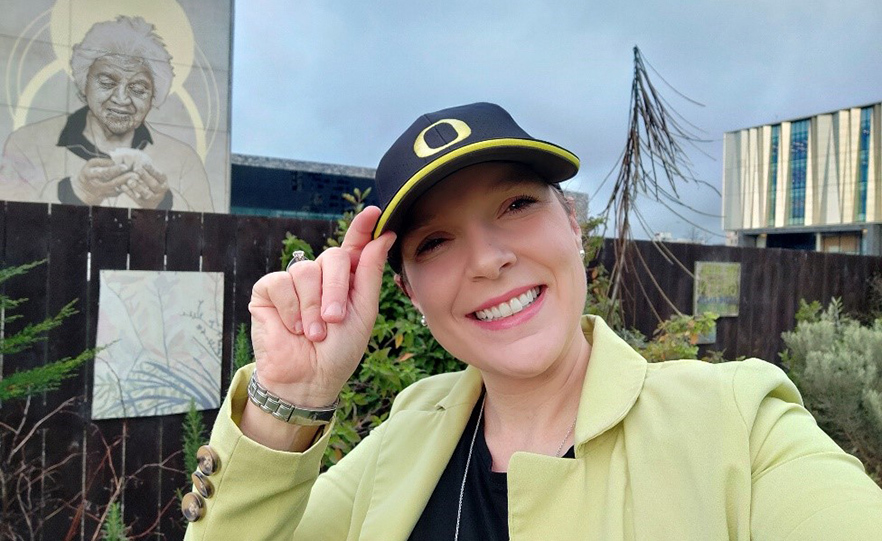
Dr Gabriella Lindberg tipping her University of Oregon cap.
An Otago Research Fellow will be opening up her own laboratory at the University of Oregon Knight Campus, after being appointed as a Lab Leader and Assistant Professor.
Dr Gabriella Lindberg completed her PhD studies and Poctdoctoral Fellowship in the Christchurch Regenerative Medicine and Tissue Engineering (CReaTE) research group, part of Otago's Department of Orthopaedic Surgery and Musculoskeletal Medicine. Dr Lindberg's research background is in bioengineering, with a specilisation in biofabrication.
Dr Lindberg will be setting up her own lab group, the Lindberg Laboratory, focusing on biological relevant 3D models.
“My vision is that we can challenge conventional design restrictions of the lab environment and use these 3D models to develop more efficient stem cell treatments for patients suffering from bone marrow diseases.”
“I'm going to use all of those skillsets I've gained in my PhD at the University of Otago together with all the mentorship I've received and now apply that to develop these robust 3D models so we can really look to translate the ideas we have in the lab more efficiently. These living models will act as a stepping stone between the laboratory and the clinic, to be able to more reliably test treatments in vitro while further allowing us to minimize the use of animal models in research.”
She will be specifically focusing on 3D models of bone marrow tissue.
“It's all about the blood stem cells that are found in the bone marrow,trying to target specifically two applications – one is recruiting and growing enough healthy stem cells to use for treatments of blood cancers, and the other is the differentiation of stem cells into red blood cells . Even though blood stem cells from the bone marrow have been researched for decades, we still don't fully understand how to grow or differentiate them in a lab environment – outside the body”
Dr Lindberg wants to develop these models to also account for the complexity of human patients' in order to have better success in the clinic.
“The regenerative capacity of stem cells is very variable between patients. So, I'm really interested in making sure we can make these models to account for patient factors but also making sure treatments can work in a diseased environment.”
Dr Lindberg hopes the 3D-models being developed at the Lindberg Laboratory will have a positive impact on patients in the future.
“My vision is that we can challenge conventional design restrictions of the lab environment and use these 3D models to develop more efficient stem cell treatments for patients suffering from bone marrow diseases.”
Dr Lindberg puts a lot of her success down to the support she has received from the University.
“The reason that I'm privileged enough to open my own lab group is because of the support I received at the University of Otago and how I was trained here.”
Her mentors and PhD supervisors, Professor Tim Woodfield and Associate Professor Khoon Lim, and Head of Department Professor Gary Hooper, were also a big part of her landing the opportunity to set up her own lab group, she says.
“They have really enabled me and given me roles to demonstrate my leadership.”
Dr Lindberg will continue to work alongside the University of Otago, keeping her students at Otago and collaborating with Professor Woodfield, Associate Professor Lim and Professor Gary Hooper.
